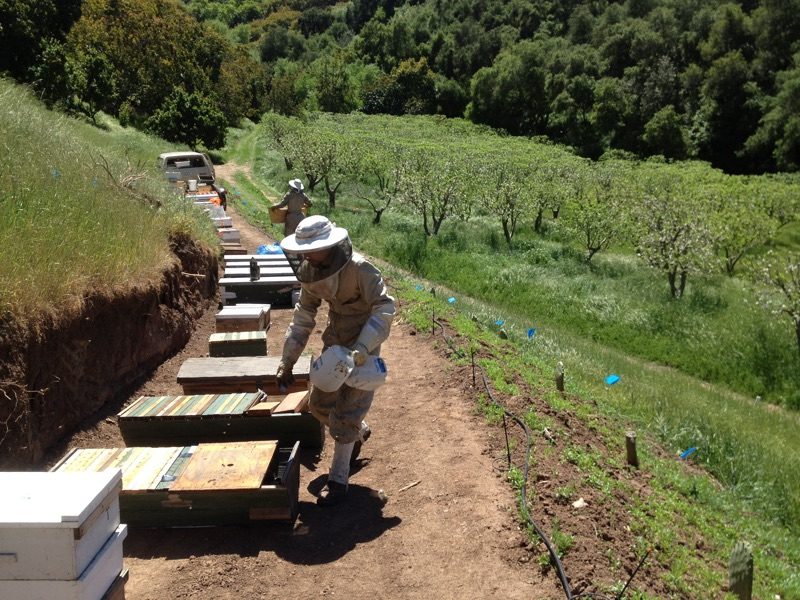Whole Farm Planning, Management Regenerative Agriculture Design For Orchards, Ranches, and Farms.

We specialize in rehabilitating farmland by improving soil quality through restoring the water and mineral cycles on the land.
Regenerating Agriculture
Farming is the cornerstone of our culture. Food is essential to our daily living, and moreover the water that grows it is crucial for our survival. This culture is at a crossroads. Water is becoming more scarce and expensive, we are losing soil at an alarming rate, production costs are going up and profit margins are decreasing.
We can help you reverse this trend.
Listed below are some of the ways we can help your farm. Call us to discuss your specific needs.
Whole Farm and Property Planning:
- Site Plans and Mapping
- Keyline® Design and plowing
- Water Management Plans
- Water System Redesign
- Rainwater Harvesting Earthworks
- Infiltration and Sedimentation Basins
- Transition to Organic and Organic Certification
- Crop Diversification/Intercropping and Value Adding
- Holistic Management® Grazing Plans and Livestock Systems
- Integrated Pest Management
- Pollinator Systems
- Infrastructure Design
- Farm Social System Design
- Enterprise Budgeting
- Compliance with local and federal regulations
Management Services:
- Water use budgeting
- Tree and plant health monitoring and care
- Fertility Management Plans
- Labor for ongoing maintenance
- Irrigation system repair and maintenance
- Soil and Leaf tissue testing
- Water testing
How we work:
We use the Holistic Management® decision-making framework and the Regrarians® Platform for helping you regenerate and re-design your farm.
Holistic Management® Decision Making Framework: (from Wikipedia)
- Define in its entirety what you are managing. No area should be treated as a single-product system. By defining the whole, people are better able to manage. This includes identifying the available resources, including money that the manager has at his disposal.
- Define what you want now and for the future. Set the objectives, goals and actions needed to produce the quality of life sought, and what the life-nurturing environment must be like to sustain that quality of life far into the future.
- Watch for the earliest indicators of ecosystem health. Identify the ecosystem services that have deep impacts for people in both urban and rural environments, and find a way to easily monitor them. One of the best examples of an early indicator of a poorly functioning environment are patches of bare ground. An indicator of a better functioning environment is newly sprouting diversity of plants and a return or increase of wildlife.
- Don’t limit the management tools you use. The eight tools for managing natural resources are money/labor, human creativity, grazing, animal impact, fire, rest, living organisms and science/technology. To be successful you need to use all these tools to the best of your ability.
- Test your decisions with questions that are designed to help ensure all your decisions are socially, environmentally and financially sound for both the short and long term.
- Monitor proactively, before your managed system becomes more imbalanced. This way the manager can take adaptive corrective action quickly, before the ecosystem services are lost. Always assume your plan is less than perfect and use a feedback loop that includes monitoring for the earliest signs of failure, adjusting and re-planning as needed. In other words use a “canary in a coal mine” adaptive approach.
Regrarians® Platform:
1. Climate and Context
a. Context
i. Goals and Visions
ii. Financial
iii. Legal
iv. Socio-Cultural
b. Biophysical Climate Summary
i. Flora and fauna
ii. Weather patterns
iii. Rainfall data
c. Base Maps and Land surveys
2. Geology, Geography, and Landshape
a. Geographic Land Components
i. Topography and soil types
ii. Riparian Corridors, Steep Slopes, Unique Features
iii. Wilderness Areas
b. Socio-Cultural Land Components
i. Property boundaries
ii. Management Areas
iii. Recreational Areas
3. Water
a. Water in the Landscape
i. Dominant Processes
ii. Sweet Spot Characterization
b. Water Collection Systems
i. Catchment Areas
ii. Storage Areas
c. Water Production and Distribution Systems
i. Wells, windmills, and pumps
ii. Reticulation-Irrigation and Piping
d. Water Features
i. Ponds and dams
e. Water Filtration
i. Point Of Use Potable Systems
ii. Waste Water filtration
iii. Bioswales and Greywater systems
4. Access
a. Access Roads and Site Circulation
b. Hardscaping, pathways
5. Forestry
a. Agroforestry Systems
i. Silvopasture
ii. Polyculture Orchards and Interplanting
iii. Timber production
b. Garden Agriculture
i. Food forests
c. Wildland Management
i. Fire
ii. Predator, prey balance
6. Buildings
a. Residential
b. Workshops, Processing, and Storage
c. Animal Shelters
d. Season Extension Structures
7. Fencing and Subdivisions
a. Livestock Paddocks
b. Animal Systems Integration
c. Plant protection from deer, birds, etc
8. Soils
a. Nutrient Cycling Patterns
i. Bullseye Method
b. Soil Renovation Strategies
i. Composting and nutrient management
ii. Animal integration
iii. Plantings
9. Economy
a. Value Adding
b. Approach:
i. Clientele and Audience
ii. Telling Your Story
iii. Point of Sales
10.Energy
a. Renewable Energy Systems
i. Solar, wind
b. Energy Recycling Systems
i. Biofuels, Biogas
